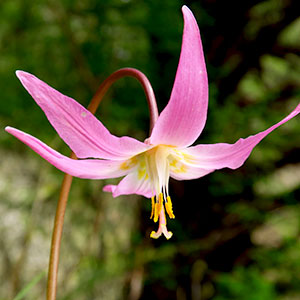Erythronium revolutum
Erythronium grandiflorum
coast fawn lily, mahogany fawn lily, pink fawn-lily
dogtooth fawn lily, glacier-lily, yellow avalanche-lily, yellow fawn-lily, yellow glacier lily
narrowly ovoid, 35–50 mm, sometimes producing sessile offsets.
slender, 30–50 mm.
10–25 mm;
blade distinctly mottled with irregular streaks of brown or white, broadly lanceolate to ovate, margins entire to ± wavy.
5–20 cm;
blade green, lanceolate, ± glaucous, base gradually narrowed to petiole, margins ± wavy.
15–40 cm.
5–30 cm.
1–3-flowered.
usually 1-flowered, sometimes up to 5-flowered.
tepals uniformly clear violet-pink at anthesis, with yellow banding at base, lanceolate to narrowly elliptic, 25–40 mm, inner with small auricles at base;
stamens ± appressed to style, 12–22 mm;
filaments white to pink (darkening with age), flattened, ± lanceolate, 2–3 mm wide;
anthers bright yellow;
style white to pink, 12–18 mm;
stigma with slender recurved lobes 4–6 mm.
tepals recurved, bright yellow with (in live specimens) narrow paler zone at base, or white to creamy white with yellow base, narrowly ovate, 20–35 mm, length at least 4 times width, inner usually auriculate at base;
stamens 11–18 mm;
filaments white, ± slender, linear, less than 0.8 mm wide;
anthers cream, yellow, red, or purplish red;
pollen yellow or red;
style white, 10–15 mm;
stigma unlobed or with slender, recurved lobes (1–)2–4 mm.
oblong to obovoid, 3–6 cm.
oblong to narrowly obovoid, 2–5 cm.
= 24.
Erythronium revolutum
Erythronium grandiflorum
Subspecies 2 (2 in the flora).
This beautiful species is often very abundant in mountain meadows of western North America, especially in the Rocky Mountains, where it may form spectacular displays. It is often difficult to grow in cultivation outside its preferred habitats. Bulbs of this species were a staple food for native North American peoples of several tribes, and were eaten in large quantities and also traded. Within the typical subspecies, both anthers and pollen vary considerably in color; plants with pale anthers have been called var. pallidum, and forms with yellow anthers, var. chrysandrum. Plants possessing very short stigma lobes and lacking auricles on the tepals have been recognized as var. nudipetalum, but they do not appear sufficiently distinct to warrant taxonomic recognition and may simply represent depauperate forms.
(Discussion copyrighted by Flora of North America; reprinted with permission.)
1. Tepals white to creamy white, with yellow zone at base; anthers cream to yellow. | subsp. candidum |
1. Tepals bright yellow, with narrow paler zone at base; anthers cream, yellow, red, or purplish red. | subsp. grandiflorum |
- Local floras:
BC,
CA,
OR,
WA
- Local Web sites:
CalFlora,
CalPhotos,
Flora NW,
PNW Herbaria,
Turner Photog.
WildflowerSearch
iNaturalist (observations)
USDA Plants Database
- LBJ Wildflower Center
- SEINet
- Plants of the World Online
- Encyclopedia of Life
- Wikipedia
- Google Image Search


